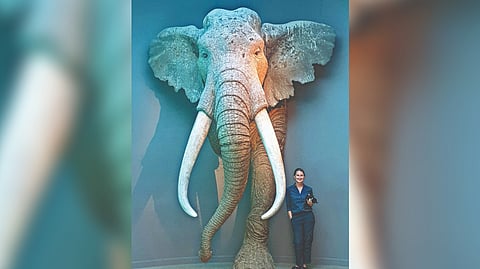

NEW YORK: In his 1931 book, “How to Tell Your Friends From the Apes,” the American satirist Will Cuppy noted that Neanderthals had fires, caves, marrow bones, mosquitoes, love and arthritis. “What more can you ask?” he mused.
If you answered “bush meat block parties,” you might be on to something. That is essentially the conclusion of a study published on Wednesday in the journal Science Advances. The paper focuses on 3,122 bones, tusks and teeth thought to derive from more than 70 straight-tusked elephants — some skeletons of which were virtually intact — that died 125,000 years ago in a heavily forested lake basin of what would come to be east-central Germany. The researchers argue that, for at least two millenniums, Neanderthals hunted there for the giant, now-extinct herbivores as part of what the paper’s lead author, Sabine Gaudzinski-Windheuser of the Monrepos Archaeological Research Center and Museum in Neuwied, Germany, called their “cultural repertoire.”
Most of the elephant carcasses were recovered during the 1980s in the site complex of Neumark-Nord, a former coal quarry. Their abundant cut marks indicated that the resident Neanderthals had used flint tools to slice off meat, and had found the remains before other carnivores such as saber-tooth tigers. “It is the first clear-cut evidence of elephant-hunting in human evolution,” said Wil Roebroeks, an archaeologist at Leiden University in the Netherlands who is an author on the paper.
By calculating the intensity and nutritional yields of the Neanderthals’ well-documented butchering activities, the research team offers further proof that our hominid cousins were cooperative hunters who knew how to preserve meat and might have lived a settled existence in large groups. The findings challenge the assumption that Neanderthals were basically nomads who lived in bands of no more than 25, in isolation from one another.
Dr. Roebroeks said that group size was the “elephant in the room” in the field of Neanderthal studies. “The idea that Neanderthals roamed about in small bands has been around since the 19th century,” he said. “But the rich Neumark-Nord elephant record points to the possibility of sizable collective-subsistence events.”
He and Dr. Gaudzinski-Windheuser were part of a 2018 investigation that proposed that the punctured bones of two male fallow deer salvaged at Neumark-Nord were the oldest example of hunting marks in history, and that Neanderthals used sophisticated close-range hunting techniques to capture their prey. He and Dr. Gaudzinski-Windheuser were part of a 2018 investigation that proposed that the punctured bones of two male fallow deer salvaged at Neumark-Nord were the oldest example of hunting marks in history, and that Neanderthals used sophisticated close-range hunting techniques to capture their prey.
It is now accepted that the more typical Neanderthal was one who lived in southern Europe through the Ice Age and in central Europe during interglacial periods, as epitomized by Neumark-Nord. About 86,000 to 106,000 years ago, for instance, fisher-hunter-gatherers occupied the Gruta da Figueira Brava site on Portugal’s Atlantic coast.
Similarly, a new body of research has transformed our image of Neanderthals as knuckle-dragging brutes who wandered from cave to cave while gnawing on slabs of slain mammoth. Evidence is mounting that they were skilled toolmakers with a complex language who built shelters, traded jewellery and lived in large social groups.
Visit news.dtnext.in to explore our interactive epaper!
Download the DT Next app for more exciting features!
Click here for iOS
Click here for Android